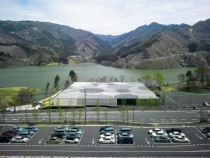
© Christian Richters
As the result of an accident in the 1970s, the Japanese painter and poet Tomihiro Hoshino is paralysed from the neck down and paints with his mouth. In 1991, a museum was opened in his home village to display his work, which is known throughout Japan. The gallery proved to be a great success and became an economic factor in the region. To present the artist’s work in an appropriate manner, an international competition for a new museum was held. The outcome was an unusual concept. Laid out to a square plan are 33 single-storey cylindrical exhibition spaces of different diameters, with light courts between them. Along the edges of the complex, the cylinders are simply cut off to fit into the square. The architect wanted to create autonomous spaces and used different materials for the finishings in the individual halls. In consultation with the artist, a range of colour tones was determined for each space, based on the surrounding landscape. Introverted halls that focus on the mainly small-scale works of art are juxtaposed with others with glazed walls that open on to a courtyard or to an artificial lake.


